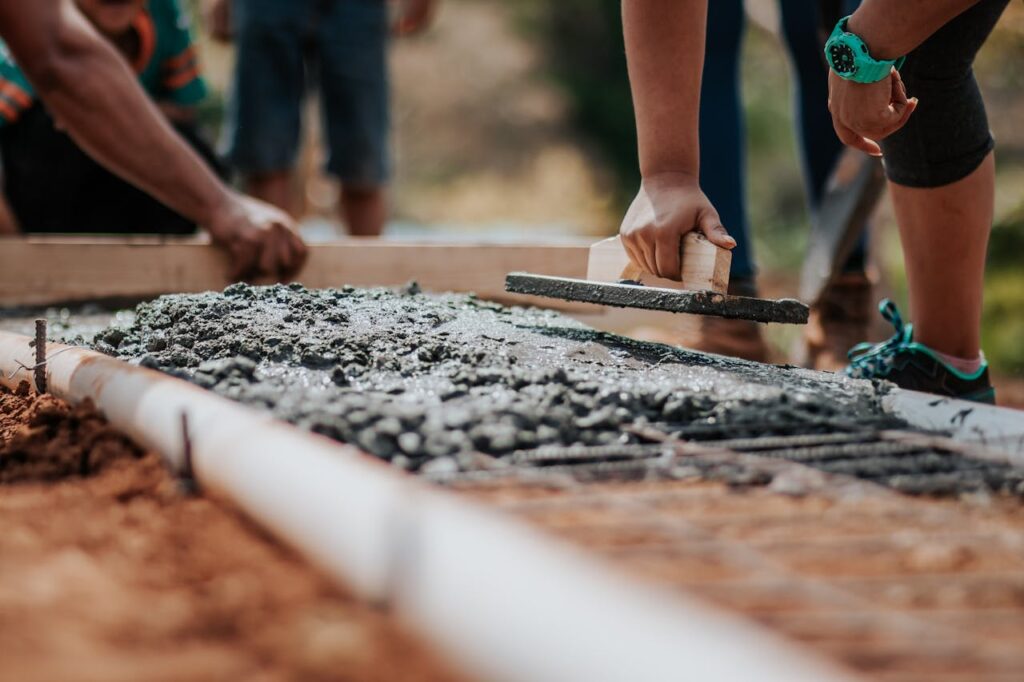Cracked sidewalks are a common sight in American neighborhoods. From harsh winters to years of wear and tear, concrete takes a beating. While a minor crack might be an eyesore, it can eventually become a safety hazard, posing a tripping risk. Fortunately, fixing cracked concrete sidewalks is a manageable project for most homeowners.
This comprehensive guide by Hi-Tech Construction NY will equip you with the knowledge to tackle concrete sidewalk repair in your USA community. We’ll delve into the different types of cracks, the best repair methods, and essential safety tips. With this information, you can restore your sidewalk’s functionality and enhance your property’s curb appeal.
Understanding the Different Types of Concrete Sidewalk Cracks
Not all sidewalk cracks are created equal. Different types of cracks require varying approaches for successful repair. Here’s a breakdown of some common types to fix concrete cracks:
- Hairline Cracks (Less than ¼ inch wide): These are superficial cracks with minimal impact on the sidewalk’s structural integrity. They can often be filled with a simple concrete caulk.
- Stress Cracks (¼ inch to ½ inch wide): These occur due to shrinkage or settling of the concrete. While not posing an immediate safety threat, they can widen over time. Early repair is recommended.
- Expansion Cracks (Wider than ½ inch): These cracks develop due to external pressure, such as tree roots growing underneath the sidewalk or shifting soil. They are a cause for concern and require a more comprehensive repair approach.
- Cracked Slabs: When a section of the concrete slab breaks away, it becomes a tripping hazard and necessitates a complete slab replacement.
Choosing the Right Repair Method
The best way to fix a cracked sidewalk depends on the crack’s severity and your DIY experience. Here are some common repair methods:
- Concrete Caulk: For hairline and minor stress cracks, a concrete caulk is a quick and easy solution. This flexible sealant fills the crack and prevents further water infiltration and expansion.
- Crack Injection (Epoxy): For wider stress cracks, an epoxy injection might be a better option. This method involves injecting a high-strength epoxy resin into the crack to fill and stabilize it. While it requires more skill than caulking, it provides a long-lasting repair.
- Mudjacking (Slab Lifting): If a section of the concrete slab has settled, mudjacking can be used to lift it back into place. This process involves injecting a slurry of crushed stone, cement, and water beneath the slab to raise and level it.
- Slab Replacement: For severely cracked slabs or broken concrete, replacing the entire slab is necessary. This is the most intensive repair method and should be undertaken by experienced DIYers or professionals.
Essential Tools and Materials for Concrete Sidewalk Repair
Before embarking on your sidewalk repair journey, ensure you have the necessary tools and materials. Here’s a basic list:
- Safety Gear: Safety glasses, gloves, dust mask, and sturdy shoes
- Cleaning Tools: Broom, wire brush, garden hose (or pressure washer)
- Crack Preparation Tools: Hammer and chisel (for wider cracks), grinder (optional)
- Caulking Supplies: Caulk gun, concrete caulk, utility knife
- Crack Injection Supplies (Epoxy method): Epoxy injection kit (with pump and resin), mixing container
- Mudjacking Supplies: Mudjacking pump, crushed stone, cement, water source (may require renting specialized equipment)
- Slab Replacement Supplies: Replacement concrete mix (appropriate for sidewalks), edging material, shovels, level, tamper
Tip: Always check your local hardware store for pre-mixed concrete patching compounds specific for sidewalk repair.
Step-by-Step Guide to Concrete Sidewalk Repair
Preparation is Key:
- Safety First: Put on safety glasses, gloves, and a dust mask before starting any work. Sturdy shoes will protect your feet from debris.
- Clear the Area: Remove any furniture, planters, or obstacles that may hinder your work.
- Clean the Crack: Thoroughly clean the crack using a broom, wire brush, and water. A pressure washer can effectively remove dirt and debris from deeper cracks.
Repairing Hairline and Minor Stress Cracks:
- Caulk Application: Once the crack is clean and dry, use a caulk gun to apply a concrete caulk according to the manufacturer’s instructions. Cut the caulk tube nozzle at an angle slightly wider than the crack. Run a smooth bead of caulk to fill the crack completely.
- Smoothing and Finishing: Use a wet finger or smoothing tool (provided with some caulk products) to smooth out the caulk and create a clean finish.
